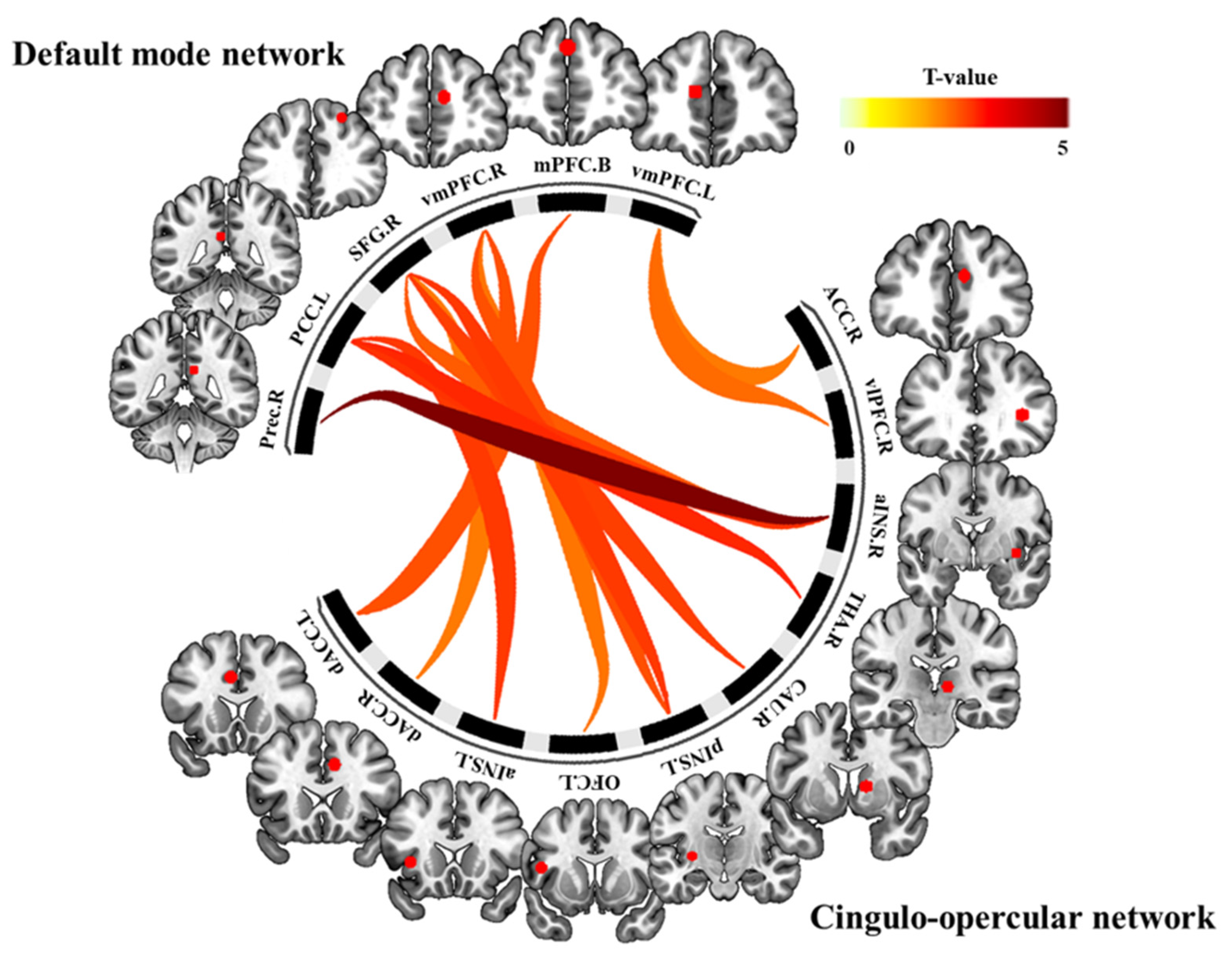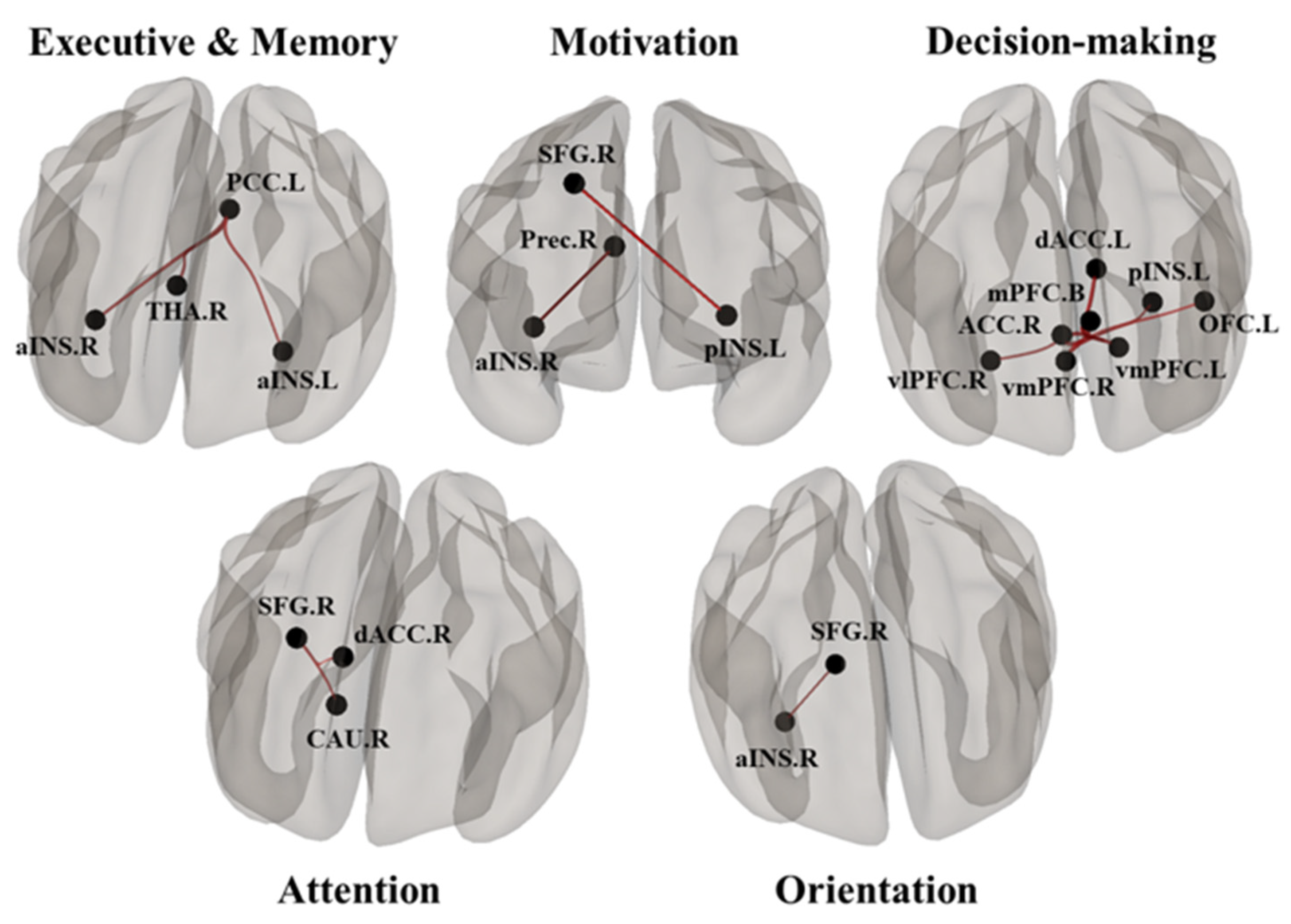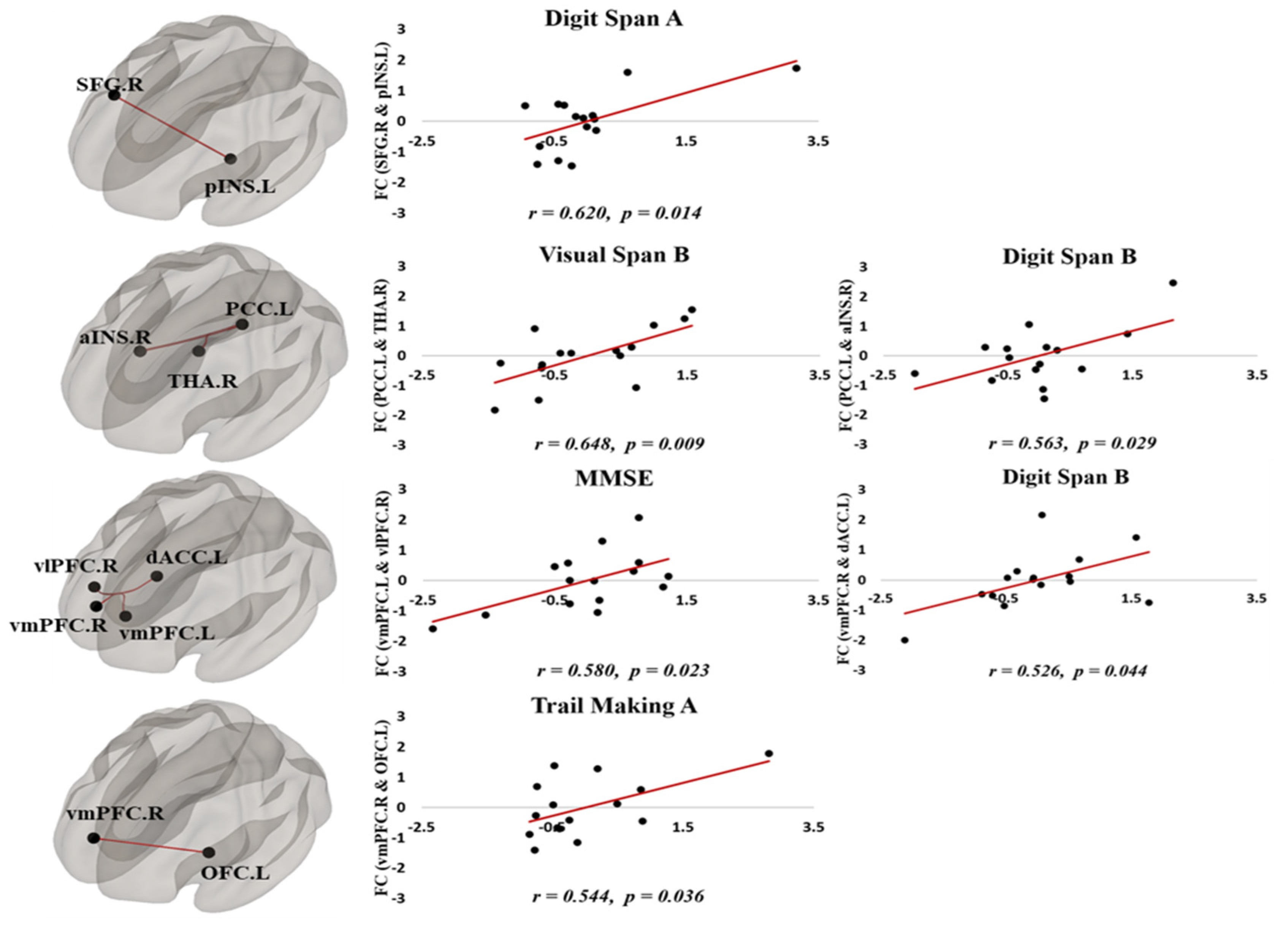Effects of Cognitive Training in Mild Cognitive Impairmentmeasured by Resting State Functional Imaging
Abstract
:1. Introduction
2. Materials and Methods
2.1. Participants
2.2. Computerized Cognitive Training (CCT) System
2.3. Neurocognitive Measurements
2.4. Image Acquisition and Analysis
2.5. Statistical Analysis
3. Results
3.1. Neurocognitive Abilities
3.2. Functional Connectivity and Correlation Analysis
4. Discussion
5. Conclusions
Author Contributions
Funding
Conflicts of Interest
References
- Grundman, M.; Petersen, R.C.; Ferris, S.H.; Thomas, R.G.; Aisen, P.S.; Bennett, D.A.; Foster, N.L.; Jack, C.R., Jr.; Galasko, D.R.; Doody, R. Mild cognitive impairment can be distinguished from Alzheimer disease and normal aging for clinical trials. Arch. Neurol. 2004, 61, 59–66. [Google Scholar] [CrossRef] [Green Version]
- Geda, Y.E. Mild cognitive impairment in older adults. Curr. Psychiatry Rep. 2012, 14, 320–327. [Google Scholar] [CrossRef]
- Boyle, P.; Wilson, R.; Aggarwal, N.; Tang, Y.; Bennett, D. Mild cognitive impairment: Risk of Alzheimer disease and rate of cognitive decline. Neurology 2006, 67, 441–445. [Google Scholar] [CrossRef]
- Teng, E.; Tassniyom, K.; Lu, P.H. Reduced quality-of-life ratings in mild cognitive impairment: Analyses of subject and informant responses. Am. J. Geriatr. Psychiatry 2012, 20, 1016–1025. [Google Scholar] [CrossRef] [Green Version]
- Lawson, R.A.; Yarnall, A.J.; Duncan, G.W.; Breen, D.P.; Khoo, T.K.; Williams-Gray, C.H.; Barker, R.A.; Collerton, D.; Taylor, J.-P.; Burn, D.J. Cognitive decline and quality of life in incident Parkinson’s disease: The role of attention. Parkinsonism Relat. Disord. 2016, 27, 47–53. [Google Scholar] [CrossRef] [PubMed] [Green Version]
- Association, A.s. 2019 Alzheimer’s disease facts and figures. Alzheimer’s Dement. 2019, 15, 321–387. [Google Scholar] [CrossRef]
- Kueider, A.; Bichay, K.; Rebok, G. Cognitive training for older adults: What is it and does it work. Cent. Aging Am. Inst. Res. 2014, 1–8. [Google Scholar]
- Wilson, R.S.; De Leon, C.F.M.; Barnes, L.L.; Schneider, J.A.; Bienias, J.L.; Evans, D.A.; Bennett, D.A. Participation in cognitively stimulating activities and risk of incident Alzheimer disease. JAMA 2002, 287, 742–748. [Google Scholar] [CrossRef] [PubMed]
- Kable, J.; Caulfield, M.K.; Falcone, M.; McConnell, M.; Bernardo, L.; Parthasarathi, T.; Cooper, N.; Ashare, R.; Audrain-McGovern, J.; Hornik, R.; et al. No Effect of Commercial Cognitive Training on Neural Activity During Decision-Making. J. Neurosci. 2017, 37, 7390–7402. [Google Scholar] [CrossRef] [Green Version]
- Simons, D.J.; Boot, W.R.; Charness, N.; Gathercole, S.E.; Chabris, C.F.; Hambrick, D.Z.; Stine-Morrow, E.A. Do “Brain-Training” programs work? Psychol. Sci. Public Interest 2016, 17, 103–186. [Google Scholar] [CrossRef]
- Kueider, A.M.; Parisi, J.M.; Gross, A.L.; Rebok, G.W. Computerized cognitive training with older adults: A systematic review. PLoS ONE 2012, 7, e40588. [Google Scholar] [CrossRef] [PubMed] [Green Version]
- Rabipour, S.; Morrison, C.; Crompton, J.; Petrucelli, M.; Germano, M.d.O.G.; Popescu, A.; Davidson, P.S. Few Effects of a 5-Week Adaptive Computerized Cognitive Training Program in Healthy Older Adults. J. Cogn. Enhanc. 2020, 4, 258–273. [Google Scholar] [CrossRef]
- Barnes, D.E.; Yaffe, K.; Belfor, N.; Jagust, W.J.; DeCarli, C.; Reed, B.R.; Kramer, J.H. Computer-based cognitive training for mild cognitive impairment: Results from a pilot randomized, controlled trial. Alzheimer Dis. Assoc. Disord. 2009, 23, 205. [Google Scholar] [CrossRef] [PubMed] [Green Version]
- Hu, M.; Wu, X.; Shu, X.; Hu, H.; Chen, Q.; Peng, L.; Feng, H. Effects of computerised cognitive training on cognitive impairment: A meta-analysis. J. Neurol. 2019, 9, e027062. [Google Scholar] [CrossRef] [PubMed]
- Klingberg, T. Training and plasticity of working memory. Trends Cogn. Sci. 2010, 14, 317–324. [Google Scholar] [CrossRef]
- Van Balkom, T.D.; van den Heuvel, O.A.; Berendse, H.W.; van der Werf, Y.D.; Vriend, C. The Effects of Cognitive Training on Brain Network Activity and Connectivity in Aging and Neurodegenerative Diseases: A Systematic Review. Neuropsychol. Rev. 2020, 30, 267–286. [Google Scholar] [CrossRef]
- Lisanne, F.; Davis, J.C.; Barha, C.K.; Liu-Ambrose, T. Effects of computerized cognitive training on neuroimaging outcomes in older adults: A systematic review. BMC Geriatr. 2017, 17, 139. [Google Scholar]
- Sheffield, J.M.; Kandala, S.; Burgess, G.C.; Harms, M.P.; Barch, D.M. Cingulo-opercular network efficiency mediates the association between psychotic-like experiences and cognitive ability in the general population. Biol. Psychiatry Cogn. Neurosci. Neuroimaging 2016, 1, 498–506. [Google Scholar] [CrossRef] [Green Version]
- Shen, X.; Cox, S.R.; Adams, M.J.; Howard, D.M.; Lawrie, S.M.; Ritchie, S.J.; Bastin, M.E.; Deary, I.J.; McIntosh, A.M.; Whalley, H.C. Resting-state connectivity and its association with cognitive performance, educational attainment, and household income in the UK Biobank. Biol. Psychiatry Cogn. Neurosci. Neuroimaging 2018, 3, 878–886. [Google Scholar] [CrossRef]
- Yin, Y.; He, X.; Xu, M.; Hou, Z.; Song, X.; Sui, Y.; Liu, Z.; Jiang, W.; Yue, Y.; Zhang, Y. Structural and functional connectivity of default mode network underlying the cognitive impairment in late-onset depression. Sci. Rep. 2016, 6, 37617. [Google Scholar] [CrossRef] [Green Version]
- Badhwar, A.; Tam, A.; Dansereau, C.; Orban, P.; Hoffstaedter, F.; Bellec, P. Resting-state network dysfunction in Alzheimer’s disease: A systematic review and meta-analysis. Alzheimer’s Dement. Diagn. Assess. Dis. Monit. 2017, 8, 73–85. [Google Scholar] [CrossRef] [PubMed]
- Sorg, C.; Riedl, V.; Mühlau, M.; Calhoun, V.D.; Eichele, T.; Läer, L.; Drzezga, A.; Förstl, H.; Kurz, A.; Zimmer, C. Selective changes of resting-state networks in individuals at risk for Alzheimer’s disease. Proc. Natl. Acad. Sci. USA 2007, 104, 18760–18765. [Google Scholar] [CrossRef] [PubMed] [Green Version]
- Petrella, J.; Sheldon, F.; Prince, S.; Calhoun, V.D.; Doraiswamy, P. Default mode network connectivity in stable vs progressive mild cognitive impairment. Neurology 2011, 76, 511–517. [Google Scholar] [CrossRef] [PubMed] [Green Version]
- Buckner, R.L.; Sepulcre, J.; Talukdar, T.; Krienen, F.M.; Liu, H.; Hedden, T.; Andrews-Hanna, J.R.; Sperling, R.A.; Johnson, K.A. Cortical hubs revealed by intrinsic functional connectivity: Mapping, assessment of stability, and relation to Alzheimer’s disease. J. Neurosci. 2009, 29, 1860–1873. [Google Scholar] [CrossRef] [PubMed] [Green Version]
- Binnewijzend, M.A.; Schoonheim, M.M.; Sanz-Arigita, E.; Wink, A.M.; van der Flier, W.M.; Tolboom, N.; Adriaanse, S.M.; Damoiseaux, J.S.; Scheltens, P.; van Berckel, B.N. Resting-state fMRI changes in Alzheimer’s disease and mild cognitive impairment. Neurobiol. Aging 2012, 33, 2018–2028. [Google Scholar] [CrossRef]
- Buckner, R.L.; Andrews-Hanna, J.R.; Schacter, D.L. The brain’s default network: Anatomy, function, and relevance to disease. Ann. N. Y. Acad. Sci. 2008, 1124, 1–38. [Google Scholar] [CrossRef] [Green Version]
- McCormick, C.; Protzner, A.B.; Barnett, A.J.; Cohn, M.; Valiante, T.A.; McAndrews, M.P. Linking DMN connectivity to episodic memory capacity: What can we learn from patients with medial temporal lobe damage? Neuroimage Clin. 2014, 5, 188–196. [Google Scholar] [CrossRef] [Green Version]
- Dhanjal, N.S.; Wise, R.J. Frontoparietal cognitive control of verbal memory recall in Alzheimer’s disease. Ann. Neurol. 2014, 76, 241–251. [Google Scholar] [CrossRef]
- Zanto, T.P.; Gazzaley, A. Fronto-parietal network: Flexible hub of cognitive control. Trends Cogn. Sci. 2013, 17, 602–603. [Google Scholar] [CrossRef] [Green Version]
- Xie, C.; Bai, F.; Yu, H.; Shi, Y.; Yuan, Y.; Chen, G.; Li, W.; Chen, G.; Zhang, Z.; Li, S.-J. Abnormal insula functional network is associated with episodic memory decline in amnestic mild cognitive impairment. Neuroimage 2012, 63, 320–327. [Google Scholar] [CrossRef] [Green Version]
- Han, S.W.; Eaton, H.P.; Marois, R. Functional fractionation of the Cingulo-opercular network: Alerting insula and updating cingulate. Cereb. Cortex 2019, 29, 2624–2638. [Google Scholar] [CrossRef] [PubMed] [Green Version]
- Snyder, A. Intrinsic brain activity and resting state networks. In Neuroscience in the 21st Century: From Basic to Clinical, 2nd ed.; Springer: New York, NY, USA, 2016; pp. 1625–1676. [Google Scholar]
- Choi, S.H.; Na, D.L.; Lee, B.H.; Hahm, D.S.; Jeong, J.H.; Yoon, S.J.; Yoo, K.H.; Ha, C.K.; Han, I.W.; Group, D.R. Estimating the validity of the Korean version of expanded clinical dementia rating (CDR) scale. J. Korean Neurol. Assoc. 2001, 19, 585–591. [Google Scholar]
- Kramer, M.; German, P.S.; Anthony, J.C.; Von Korff, M.; Skinner, E.A. Patterns of mental disorders among the elderly residents of eastern Baltimore. J. Am. Geriatr. Soc. 1985, 33, 236–245. [Google Scholar] [CrossRef] [PubMed]
- Weissman, M.M.; Myers, J.; Tischler, G.; Holzer, C.; Leaf III, P.; Orvaschel, H.; Brody, J. Psychiatric disorders (DSM-III) and cognitive impairment among the elderly in a US urban community. Acta Psychiatr. Scand. 1985, 71, 366–379. [Google Scholar] [CrossRef] [PubMed]
- Lee, J.H.; Lee, K.U.; Lee, D.Y.; Kim, K.W.; Jhoo, J.H.; Kim, J.H.; Lee, K.H.; Kim, S.Y.; Han, S.H.; Woo, J.I. Development of the Korean Version of the Consortium to Establish a Registry for Alzheimer’s Disease Assessment Packet (CERAD-K) clinical and neuropsychological assessment batteries. J. Gerontol. Ser. B Psychol. Sci. Soc. Sci. 2002, 57, P47–P53. [Google Scholar] [CrossRef] [PubMed] [Green Version]
- Kim, Y.H.; Ko, M.H.; Seo, J.H.; Park, S.H.; Kim, K.S.; Jang, E.H.; Park, S.W.; Park, J.H.; Cho, Y.J. Effect of Computer-Assisted Cognitive Rehabilitation Program for Attention Training in Brain Injury. J. Korean Acad. Rehabil. Med. 2003, 27, 830–839. [Google Scholar]
- Kim, Y.H.; Shin, S.H.; Park, S.H.; Ko, M.H. Cognitive Assessment for Patient with Brain Injury by Computerized Neuropsychological Test. J. Korean Acad. Rehabil. Med. 2001, 25, 209–216. [Google Scholar]
- Shim, J.-M.; Kim, H.-H.; Lee, Y.-S. Effects of computerized neurocognitive function program induced memory and attention for patients with stroke. J. Korean Phys. Ther. 2007, 19, 25–32. [Google Scholar]
- Dosenbach, N.U.; Nardos, B.; Cohen, A.L.; Fair, D.A.; Power, J.D.; Church, J.A.; Nelson, S.M.; Wig, G.S.; Vogel, A.C.; Lessov-Schlaggar, C.N. Prediction of individual brain maturity using fMRI. Science 2010, 329, 1358–1361. [Google Scholar] [CrossRef] [Green Version]
- Jafri, M.J.; Pearlson, G.D.; Stevens, M.; Calhoun, V.D. A method for functional network connectivity among spatially independent resting-state components in schizophrenia. Neuroimage 2008, 39, 1666–1681. [Google Scholar] [CrossRef] [Green Version]
- Cao, W.; Cao, X.; Hou, C.; Li, T.; Cheng, Y.; Jiang, L.; Luo, C.; Li, C.; Yao, D. Effects of cognitive training on resting-state functional connectivity of default mode, salience, and central executive networks. Front. Aging Neurosci. 2016, 8, 70. [Google Scholar] [CrossRef] [PubMed] [Green Version]
- Woods, D.L.; Kishiyama, M.M.; Yund, E.W.; Herron, T.J.; Edwards, B.; Poliva, O.; Hink, R.F.; Reed, B. Improving digit span assessment of short-term verbal memory. J. Clin. Exp. Neuropsychol. 2011, 33, 101–111. [Google Scholar] [CrossRef] [PubMed] [Green Version]
- Li, R.; Zhang, S.; Yin, S.; Ren, W.; He, R.; Li, J. The fronto-insular cortex causally mediates the default-mode and central-executive networks to contribute to individual cognitive performance in healthy elderly. Hum. Brain Mapp. 2018, 39, 4302–4311. [Google Scholar] [CrossRef] [Green Version]
- Smallwood, J.; Gorgolewski, K.J.; Golchert, J.; Ruby, F.J.; Engen, H.G.; Baird, B.; Vinski, M.; Schooler, J.; Margulies, D.S. The default modes of reading: Modulation of posterior cingulate and medial prefrontal cortex connectivity associated with comprehension and task focus while reading. Front. Hum. Neurosci. 2013, 7, 734. [Google Scholar] [CrossRef] [Green Version]
- Wright, H.; Li, X.; Fallon, N.B.; Crookall, R.; Giesbrecht, T.; Thomas, A.; Halford, J.C.; Harrold, J.; Stancak, A. Differential effects of hunger and satiety on insular cortex and hypothalamic functional connectivity. Eur. J. Neurosci. 2016, 43, 1181–1189. [Google Scholar] [CrossRef] [PubMed] [Green Version]
- Zhang, Y.; Mei, W.; Zhang, J.X.; Wu, Q.; Zhang, W. Decreased functional connectivity of insula-based network in young adults with internet gaming disorder. Exp. Brain Res. 2016, 234, 2553–2560. [Google Scholar] [CrossRef]
- Zhang, H.-Y.; Wang, S.-J.; Xing, J.; Liu, B.; Ma, Z.-L.; Yang, M.; Zhang, Z.-J.; Teng, G.-J. Detection of PCC functional connectivity characteristics in resting-state fMRI in mild Alzheimer’s disease. Behav. Brain Res. 2009, 197, 103–108. [Google Scholar] [CrossRef]



| Participants (N = 15) | Pre-Comcog | Post-Comcog | Paired t-Test (t) | Wilcoxon Signed-Rank Test (z) | Effect Size (d) |
|---|---|---|---|---|---|
| Age (years) | 74.3 ± 5.83 | ||||
| Education (years) | 6.0 ± 3.113 | ||||
| BDI | 9.6 ± 8.10 | 10.3 ± 8.23 | −0.420 | 0.082 | |
| CDR | 0.8 ± 0.25 | 0.5 ± 0.37 | −2.828 ** | 1.186 † | |
| MMSE | 24.3 ± 3.08 | 26.9 ± 2.57 | 6.011 * | 1.513 † | |
| CNT (t-value) | |||||
| Verbal memory test | |||||
| Digit span A | 32.1 ± 5.28 | 39.9 ± 11.62 | −3.197 ** | 0.951 † | |
| Digit span B | 36.4 ± 6.86 | 45.1 ± 7.77 | 3.708 ** | 0.954 † | |
| Verbal learning | 28.7 ± 3.47 | 29.3 ± 3.97 | −0.535 | 0.225 | |
| Verbal delayed recall | 30.9 ± 5.49 | 36.6 ± 7.98 | 3.332 * | 0.866 † | |
| Visual memory test | |||||
| Visual span A | 34.1 ± 9.44 | 37.5 ± 9.12 | 1.379 | 0.363 | |
| Visual span B | 33.3 ± 7.56 | 37.8 ± 7.31 | 2.802 * | 0.718 † | |
| Visual learning | 37.9 ± 11.44 | 41.9 ± 11.48 | −2.804 ** | 0.669 | |
| Visual delayed recall | 46.2 ± 7.94 | 51.4 ± 8.29 | 3.948 ** | 1.021 † | |
| Attention test | |||||
| Visual CPT | 49.1 ± 19.25 | 56.2 ± 18.67 | −2.366 * | 0.653 | |
| Auditory CPT | 48.9 ± 18.23 | 51.6 ± 14.27 | 1.286 | 0.335 | |
| Visuo-motor coordination | |||||
| Trail-making A | 41.3 ± 11.15 | 46.7 ± 12.34 | −2.810 ** | 0.775 † | |
| Trail-making B | 43.8 ± 15.28 | 49.0 ± 19.61 | −2.324 * | 0.602 | |
| High cognition test | |||||
| Card sorting test | 54.9 ± 22.96 | 62.5 ± 15.49 | −2.197 * | 0.543 | |
| Word color test | 35.6 ± 11.38 | 41.4 ± 14.08 | −2.207 * | 0.570 | |
| Comparison | Regions in Network | Left/Right | Coordinates (mm) | Connectivity (T-Value) | |||
|---|---|---|---|---|---|---|---|
| DMN | CON | x | y | z | |||
| Post > Pre | Precuneus | R | 9 | −43 | 25 | ||
| aINS | R | 37 | −2 | −3 | 4.73 | ||
| PCC | L | −5 | −43 | 25 | |||
| aINS | L | −36 | 18 | 2 | 2.68 | ||
| aINS | R | 37 | −2 | −3 | 2.73 | ||
| Thalamus | R | 11 | −24 | 2 | 2.83 | ||
| SFG | R | 23 | 33 | 47 | |||
| pINS | L | −30 | −14 | 1 | 2.70 | ||
| aINS | R | 37 | −2 | −3 | 2.41 | ||
| dACC | R | 9 | 20 | 34 | 2.16 | ||
| Caudate | R | 14 | 6 | 7 | 2.67 | ||
| mPFC | B | 0 | 51 | 32 | |||
| dACC | L | −6 | 17 | 34 | 2.49 | ||
| vmPFC | L | −11 | 45 | 17 | |||
| ACC | R | 9 | 39 | 20 | 2.15 | ||
| vlPFC | R | 34 | 32 | 7 | 2.28 | ||
| vmPFC | R | 9 | 51 | 16 | |||
| dACC | L | −6 | 17 | 34 | 2.50 | ||
| OFC | L | −46 | 10 | 14 | 2.22 | ||
| pINS | L | −30 | −14 | 1 | 2.53 | ||
Publisher’s Note: MDPI stays neutral with regard to jurisdictional claims in published maps and institutional affiliations. |
© 2020 by the authors. Licensee MDPI, Basel, Switzerland. This article is an open access article distributed under the terms and conditions of the Creative Commons Attribution (CC BY) license (http://creativecommons.org/licenses/by/4.0/).
Share and Cite
Kim, S.; Park, E.; Cha, H.; Jung, J.-C.; Jung, T.-D.; Chang, Y. Effects of Cognitive Training in Mild Cognitive Impairmentmeasured by Resting State Functional Imaging. Behav. Sci. 2020, 10, 175. https://doi.org/10.3390/bs10110175
Kim S, Park E, Cha H, Jung J-C, Jung T-D, Chang Y. Effects of Cognitive Training in Mild Cognitive Impairmentmeasured by Resting State Functional Imaging. Behavioral Sciences. 2020; 10(11):175. https://doi.org/10.3390/bs10110175
Chicago/Turabian StyleKim, Seungho, Eunhee Park, Hyunsil Cha, Jae-Chang Jung, Tae-Du Jung, and Yongmin Chang. 2020. "Effects of Cognitive Training in Mild Cognitive Impairmentmeasured by Resting State Functional Imaging" Behavioral Sciences 10, no. 11: 175. https://doi.org/10.3390/bs10110175





